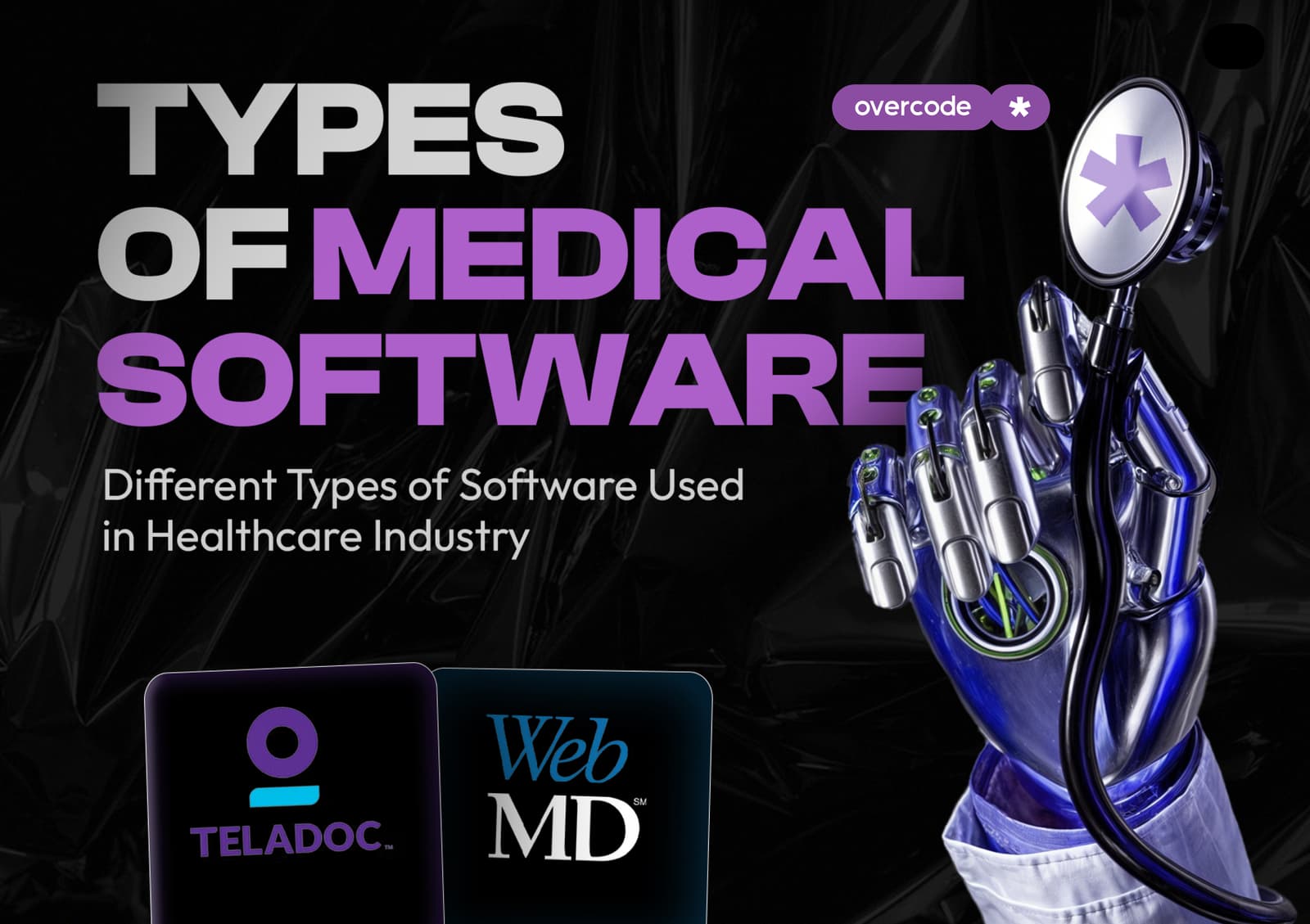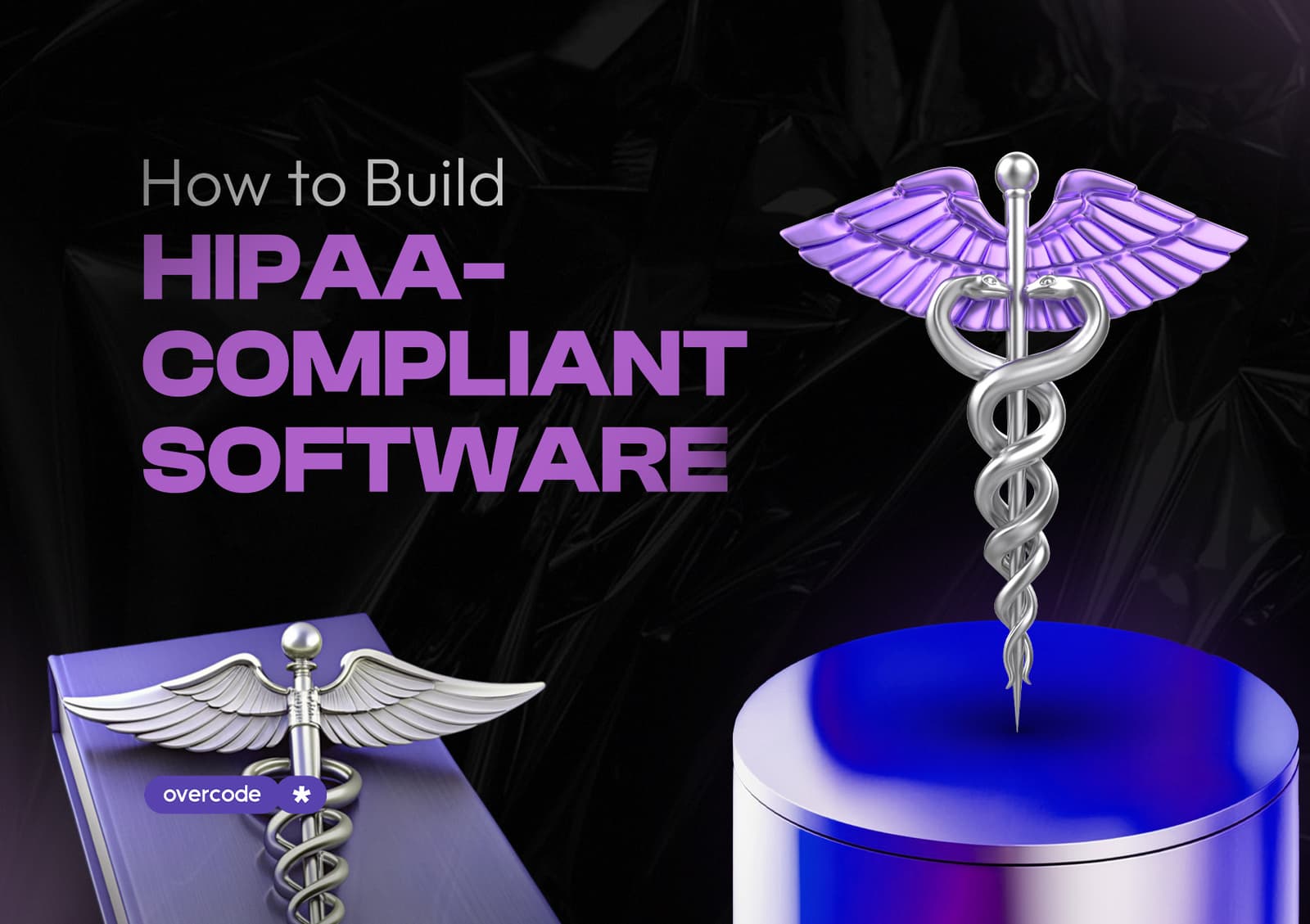The healthcare industry is at a critical inflection point. According to McKinsey, health systems that successfully invest in digital and analytics capabilities could unlock a colossal $200 billion to $360 billion in value. As patient expectations evolve and operational challenges intensify, software development in healthcare is a potent driver of digital transformation.
Booking appointments, analyzing complex medical data, and everything in between, software drives healthcare to be faster, smarter, and more efficient.
There’s no one-size-fits-all solution. Some tools help doctors track patient records, others simplify billing, and some use artificial intelligence to assist in diagnoses. The right software cuts admin inconveniences, improves patient care, and can even save lives.
Here's a look at five essential types of medical software, what they do, and how they’re transforming the industry.
5 different types of software used in healthcare industry
Analysts such as McKinsey's are convinced that the healthcare industry is in transition, with the share of healthcare services and technologies (HST) growing within the overall niche. There will be more and more different types of medical software as HST sales are expected to grow at a compound growth rate of 8% from 2023 to 2028, driven by innovations such as generative AI and the increased use of data analytics by providers and payers.
What software is used in healthcare in the meantime? Today, most software used in healthcare is called to improve administrative processes, better patient outcomes, and increase operational efficiency for all the healthcare stakeholders. Key areas of software development interest include electronic medical records (EMR), medical information systems, and data analytics platforms.
A Deloitte survey shows that around 70% of healthcare executives focus on investments in technology platforms for digital tools and services, while 60% highlight the importance of EMR and ERP systems.
On top of that, Gartner highlights that cybersecurity, business intelligence/data analytics, and cloud platforms are the top investment priorities driving the development of different types of software used in the healthcare industry.
Let’s break down the key healthcare solutions, on the market their features, and the benefits they bring.
Medical practice management software
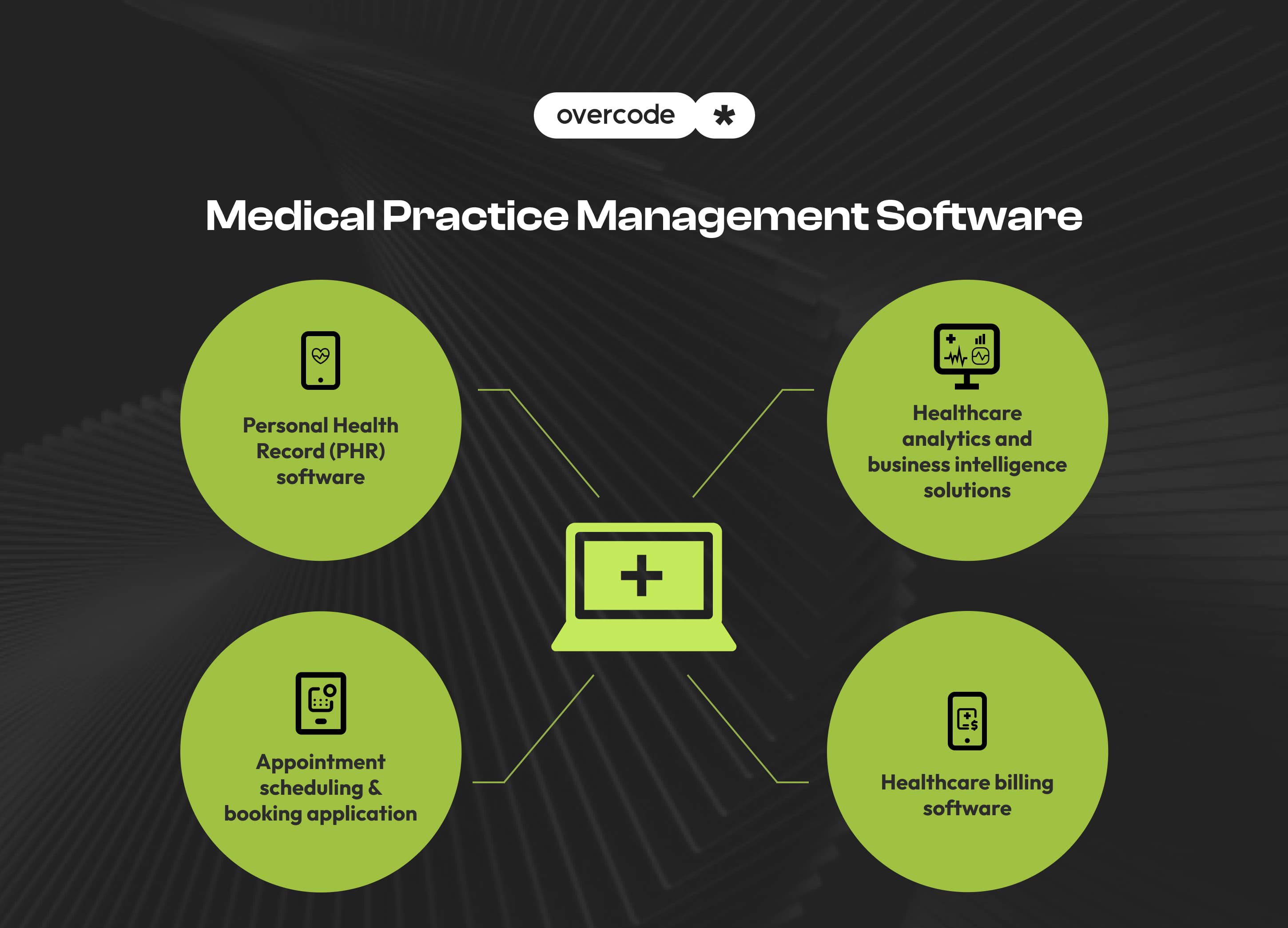
More than just providing patient care, a medical practice must run like an efficient business. It needs this software to keep operations in check, handling scheduling, billing, and record-keeping so providers can focus on what matters most: treating patients.
Personal health record (PHR) software
This medical practice software gives patients access to their medical info, letting them track, store, and share health data on their own terms. This means no more scrambling for records at the doctor’s office.
What it does:
PHR software organizes patient records in a centralized location. It connects with wearables and fitness trackers to monitor real-time health data. It also tracks prescriptions and doctor visits to ensure patients don't miss appointments or scheduled medications. Data-sharing tools make it easy to access digital medical records, which is especially critical during emergency situations.
How it helps:
Access to health information gives patients a degree of control over their health and wellness. It helps them manage chronic illnesses, allowing them to track vital signs like blood pressure, heart rate, and blood sugar levels. It’s also easier to communicate the results with doctors.
Example solutions:
Apple Health brings health data like hospital records, lab results, and fitness stats into one easy-to-use app. MyChart by Epic puts your medical records, doctor messages, and appointment scheduling right at your fingertips.
Appointment scheduling & booking application
No one likes waiting on hold to book a doctor’s appointment. This type of hospital software makes scheduling easy for both patients and providers, cutting down on missed visits and confusion.
What it does:
Appointment scheduling software allows patients to book appointments without the back-and-forth calls. It also sends automated SMS and email reminders to keep everyone on track. Calendar syncing tools update provider schedules in real time and smart waitlist management fills last-minute cancellations with ease. This healthcare software application commonly comes with a built-in telehealth tool that supports virtual visits to improve patient experience.
How it helps:
Appointment scheduling software cuts down admin hassle while minimizing no-shows. It allows patients to book an appointment with just a few clicks and allows healthcare providers to stay organized. It also syncs smoothly with existing electronic health records, keeping everything connected without the hassle.
Example solutions:
Zocdoc allows patients to find doctors and book appointments online.
Acuity Scheduling syncs calendars, automates reminders, and keeps appointment management hassle-free.
Healthcare analytics and business intelligence solutions
Hospitals and clinics generate tons of data. BI and analytics software turns that information into actionable insights, helping healthcare teams improve care, efficiency, and finances.
What it does:
BI software provides smarter health predictions, forecasting patient risks and trends before they happen. It also keeps an eye on revenue, costs, and financial health, allowing clinics and hospitals to function as efficient business entities. You can also count on this software solution for healthcare to analyze community-wide health data for better planning, flag potential risks to keep everything regulation-ready and present all relevant information on a custom dashboard.
How it helps:
BI software allows medical practitioners to make smarter calls and provide better patient care, allowing them to improve treatments and outcomes. It spots waste, cuts unnecessary costs, and prevents hefty fines by keeping up with healthcare regulations.
Example solutions:
IBM Watson Health breaks down complex medical data so doctors can make smarter treatment calls and hospitals can run smoother. Embryonics IVF app uses artificial intelligence to help doctors make data-driven decisions to enhance embryo selection and patient outcomes.
Healthcare billing software
Billing in healthcare is a challenge, with constantly changing codes, insurance rules, and compliance hurdles making it tough to keep up. Medical billing software takes the stress out of the process, automating invoices, reducing errors, and ensuring providers get paid without the hassle.
What it does:
This software, used in healthcare, automates insurance processing to speed up approvals. It’s capable of confirming patient eligibility on the spot. It also creates and manages bills, monitors transactions, and keeps balances in check, all while ensuring HIPAA compliance to protect patient data.
How it helps:
Medical billing and revenue cycle software does a great job of ensuring invoices are accurate and error-free. For healthcare organizations, it speeds up revenue collection, frees up staff for more important tasks, and keeps financial transactions transparent and organized. It also helps hospitals and clinics stay on the right side of the law.
Example solutions:
AthenaCollector simplifies claims processing and automates patient billing. AdvancedMD is a full-suite billing and practice management system that automates finances and syncs effortlessly with EHRs.
Clinical software

Clinical software provides the record-keeping and data analysis tools that enable healthcare professionals to make smarter decisions and improve communication. It eliminates guesswork and reduces errors, allowing doctors to increase the accuracy of their diagnoses.
Electronic health records software
Electronic health records (EHRs) store and manage patient histories, treatment plans, and test results. They provide real-time access and ensure healthcare providers stay in sync.
What it does:
EHR software comes with secure storage that organizes patient records. It integrates with labs, medical imaging software, and billing systems and enables real-time access to data. It automatically reminds patients about upcoming checkups and allows them to schedule appointments and view records online.
Note that it’s distinct from electronic medical records software (EMRs) and electronic patient record software (EPSs).
EMR systems are digital versions of paper charts used within a single provider’s office, containing medical history, diagnoses, and treatments but not easily shared outside that practice. EPRs expand on this by covering an entire healthcare organization, such as a hospital network, integrating records across departments but still lacking full external data exchange.
EHRs go a step further, designed as an advanced seamless information sharing across multiple healthcare providers, ensuring a complete, patient-centered record accessible across different facilities, improving coordinated care.
How it helps:
This software for the healthcare industry trims down the admin hassles by streamlining workflows, allowing users to ditch the paperwork. Patients, on the other hand, gain easy access to up-to-date and accurate medical information.
Superior to EMRs and EPSs, which fall short in terms of scope and interoperability, EHRs provide a more comprehensive view of a patient’s health, improving care coordination.
Example solutions:
Epic Systems provides hospitals and clinics with everything they need to manage patient information effortlessly. Meditech Expanse works on interoperability, making data-sharing between providers smooth and efficient.
Clinical decision support systems (CDSS)
CDSS gives doctors AI-powered insights, alerts, and recommendations, helping them make informed decisions faster.
What it does:
CDSS uses AI to offer predictive diagnostics that help doctors make smarter decisions. It connects with EHRs and pharmacy records to put together a full picture of patient conditions and create personalized care plans.
How it helps:
AI-backed insights enable accurate diagnoses, compliance with medical guidelines, and improved patient outcomes.
Example solutions:
Wolters Kluwer UpToDate improves decision-making at the point of care with evidence-based clinical guidance. MEDITECH delivers real-time alerts to keep hospital workflows running smoothly.
Medical diagnosis software
AI and data crunching power up this software to assist in disease detection and diagnosis with better accuracy and speed.
What it does:
Medical diagnosis software pores through medical data to spot patterns and make accurate diagnoses. It makes sense of test results and flags potential health issues. It enables seamless integration with MRIs, CT scans, and other machines.
How it helps:
Medical diagnosis software speeds up the detection of diseases, reduces errors and misreads, and analyzes complex medical conditions. It also syncs up with MRI, CT scans, and lab results, allowing for a more comprehensive assessment.
Example solutions:
PathAI uses machine learning to assist pathologists in diagnosing diseases faster and more accurately. Qure.ai analyzes X-rays and CT scans, quickly providing doctors with the second opinions they seek.
E-prescribing software
This software sends prescriptions directly to pharmacies, cutting out paper slips and reducing errors.
What it does:
E-prescribing software goes beyond just sending medication orders to the pharmacy, it flags risky drug interactions, tracks refills, and verifies insurance coverage on the spot. It also links up with EHRs and pharmacy databases.
How it helps:
E-prescribing software prevents prescription mix-ups, handwriting mistakes, and fraud. It saves time for medical practitioners, as it cuts down manual paperwork. It also enables smooth coordination with pharmacies, allowing them to keep orders accurate and hassle-free. Patients, on the other hand, are able to stay on track with their medications.
Example solutions:
DrFirst offers access to full prescription history, assesses insurance costs, and provides adherence tools to help patients stay on track with their medication. Surescripts boasts a nationwide network that makes e-prescribing safer and more comprehensive.
Telehealth and remote monitoring software

Telehealth software is what allows patients to access their doctors without leaving their homes. Virtual consultations and remote monitoring make patient engagement easier, allowing hospitals, clinics, and private practices to improve care and cut down on unnecessary in-person visits.
Alternative sites of care, such as virtual health or hospital-at-home, could help meet changing patient expectations demanding better accessibility of healthcare services. Nearly 90% of health system executives surveyed by Deloitte expect the expanding adoption of connected care delivery and virtual health to influence their strategies in 2025.

Telemedicine software
This telehealth software brings healthcare to patients wherever they are with virtual consultations, e-prescriptions, and automated scheduling. It enables doctors to diagnose, prescribe, and manage care without in-person visits, reducing hospital congestion and saving time for both patients and providers.
What it does:
Telemedicine software makes room for remote consultations with video conferencing technology, secure messaging via private chats, and hassle-free file sharing. It also comes with tools for setting appointments and sending e-prescriptions directly to the pharmacy. A use case example can be integrating it with EHR/EMR to keep patient records up-to-date and accessible.
How it helps:
Telemedicine software enables patients to see a doctor without having to take long commutes or spending too much time in waiting rooms. They don’t only get to save time but money as well. It’s also easier to keep communication lines open for follow-up consultations. Hospitals are better able to manage the flow of patients, automating admin work and allowing medical practitioners to focus more on providing care.
Example solutions:
Teladoc Health allows patients to access reliable healthcare from everywhere with a platform that connects them with doctors. Overcode’s custom telemedicine app offers secure video calls, messaging, and digital prescriptions, making remote healthcare fast, convenient, and compliant.
Build reliable healthcare software with confidence
We design and develop secure, compliant, and user-friendly healthcare solutions - from patient apps to complex medical platforms.
Remote patient monitoring software
A remote patient monitoring (RPM) system uses digital technology to track patient health outside of traditional clinical settings. It uses wearables and connected medical devices to continuously collect data like heart rate, blood pressure, and oxygen levels.
What it does:
RPM comes with health-tracking tools that monitor vitals like heart rate, blood pressure, and oxygen levels in real time. It syncs with ECG watches, smartwatches, and other wearables, flagging issues and sending instant alerts when something needs medical attention. AI-powered insights spot trends to identify or predict potential health risks. User-friendly dashboards and self-monitoring apps keep patients in the loop.
How it helps:
We have included RPM in our top-notch medical software list as it has proven to be efficient in the continuous patient monitoring necessary to identify health problems early and prevent escalation and hospital readmissions. It’s also ideal for managing chronic diseases, such as diabetes and hypertension. Remote tracking brings convenience to patients, allowing for fewer trips to the doctor. It also gives doctors real-time data to fine-tune treatments.
Example solutions:
CareSimple keeps patients and doctors connected with real-time tracking, smart alerts, and EHR syncing. Threshold, a senior care app, connects caregivers, families, and healthcare providers, making it easier to coordinate care, track health metrics, and support independent living.
Hospital management software
A hospital management system (HMS) streamlines hospital operations by managing patient care, medical inventory, staff scheduling, and administrative tasks. Acting as a central hub, this software ensures smoother workflows, better resource allocation, and improved patient experiences.
Healthcare CRM
This type of healthcare technology serves as a personal assistant for facilitating patient interactions. It schedules appointments, tracks communications, and boosts engagement.
What it does:
This healthcare software type keeps a record of every call, email, and message, making it easy to track patient interactions. It automates appointment scheduling and sends reminders. It integrates with EHR to access digital medical records, using the data to customize outreach and follow-ups.
How it helps:
A healthcare CRM provides the data medical practitioners need to provide personalized care and keep patients engaged with targeted outreach. Automated scheduling and reminders simplify the booking process and cut down on missed appointments.
Example solutions:
HubSpot for Healthcare comes with smart outreach tools that automate communication, track patient interactions, and boost engagement. Zoho CRM Healthcare Edition simplifies scheduling and syncs with EHRs for smoother clinic operations.
Medical equipment management software
Hospitals rely on expensive equipment, and this software makes sure it’s always working when needed.
What it does:
This type of medical software system takes charge of monitoring the location, status, and usage of medical equipment, sending out maintenance alerts when needed. It schedules routine servicing and calibration to prevent unexpected failures. The software also ensures equipment is up to industry standards, keeping it ready for audits. It tracks purchase history, monitors depreciation, and provides data on performance, downtime, and utilization to optimize resources.
How it helps:
This software ensures equipment is running when you need it, especially for life-saving procedures. It automates servicing and keeps things running smoothly. Hospitals save money by optimizing the use of existing equipment, preventing overbuying, and ensuring regulatory compliance.
Example solutions:
GE Healthcare Asset Management keeps hospital equipment in check with real-time tracking, automated maintenance, and built-in compliance tools. IBM Maximo for Healthcare helps you avoid breakdowns, track equipment lifespan, and make the most of your medical assets.
Supply chain management systems
Hospitals cannot afford to run out of essentials, not when they’re handling life-or-death situations. This type of software used in the healthcare industry keeps medical supplies stocked and costs low.
What it does:
Supply chain and management software automates the monitoring of stock levels and the placement of reorders. It also tracks vendor relationships, delivery flow, and spending patterns.
How it helps:
Supply chain and management software ensures hospitals never have a shortage of critical supplies, keeping them prepared to handle emergencies. It also ensures you’re purchasing the right amount of supplies and that your orders arrive on schedule. You can count on it to prevent overstocking, expired products, and overall wastage.
Example solutions:
SAP Ariba for Healthcare keeps hospitals stocked with the right supplies, automates reorders, and helps negotiate better deals with vendors. Oracle SCM Cloud is a great tool for tracking inventory in real time, preventing shortages, and cutting waste so hospitals always have what they need without the extra clutter.
Medical database software
This software stores all patient data in one place, keeping everything secure and easy to access. It is a must-have for research and medical decision-making.
What it does:
Medical database software ensures secure storage by encrypting the data. Quick search features allow users to instantly retrieve the records they need. Data-sharing tools enable collaboration across providers. AI-powered analytics and reporting provide insights for treatment and research.
How it helps:
This type of software used in healthcare keeps patient data safe from breaches. It also allows doctors to make data-backed decisions and provide better treatment plans and precise care. Its data-sharing tools facilitate teamwork between medical practitioners.
Example solutions:
Health Catalyst delivers cloud-based data warehousing and analytics to help healthcare providers manage and interpret digital medical records efficiently. OpenMRS is a no-fuss, open-source medical database that keeps patient records secure, easy to access, and ready to share when needed.
Medical device software
Medical device software makes medical equipment smarter, improving diagnostics, monitoring, and treatment. It’s a must-have in modern healthcare for precision and efficiency.
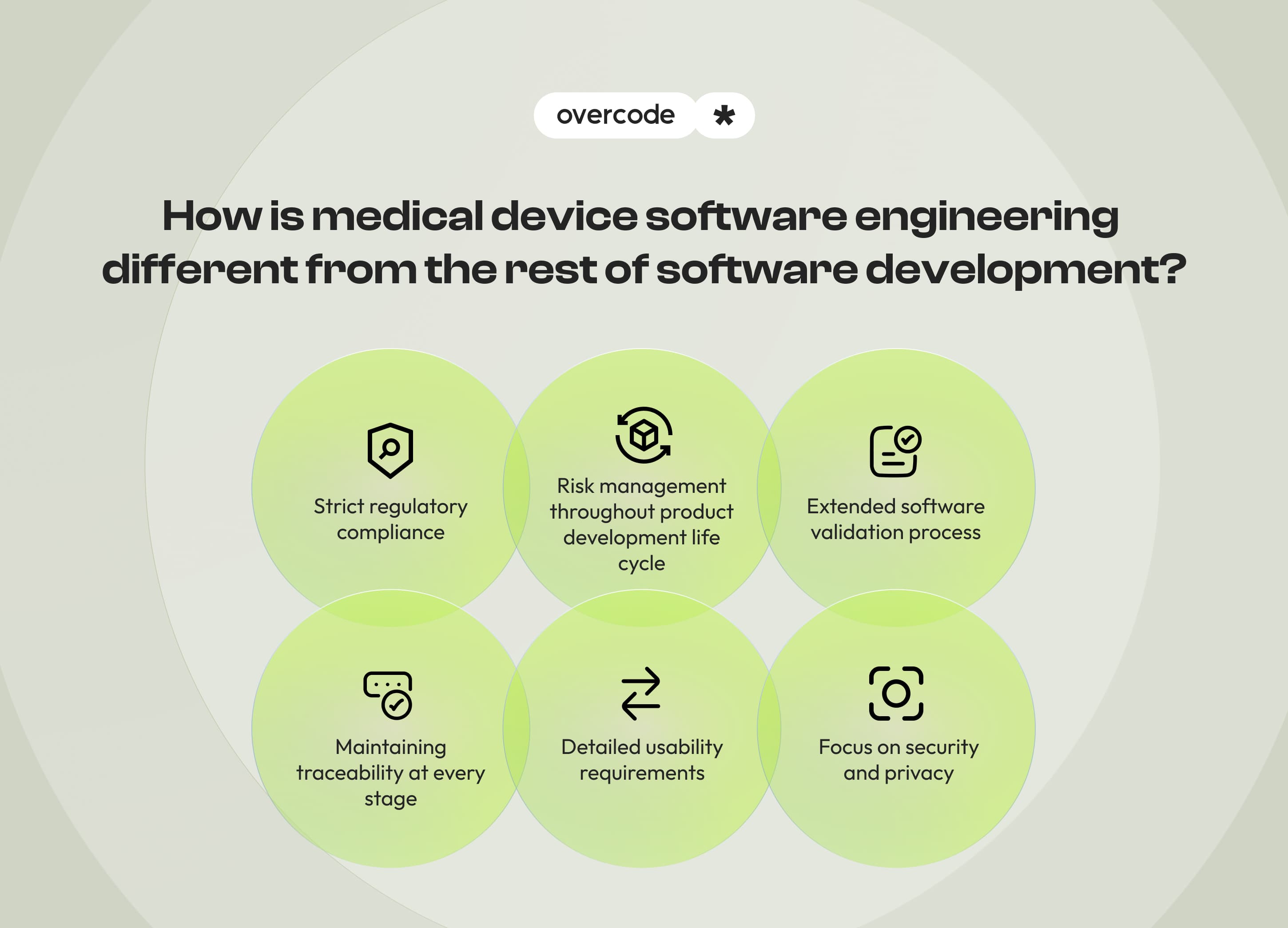
Health tracking apps
Health tracking applications come with tracking features that enable people to stay on top of their fitness, diet, sleep, and vital signs. They contribute to personal wellness and preventive care.
What it does:
This type of healthcare software syncs with wearables to monitor steps, calories, and workouts. It also tracks and analyzes sleep quality, records food and water intake, and uses personalized insights to offer tailored health recommendations.
How it helps:
Medical device software provides instant feedback and encourages healthy habits that stick. It syncs with doctors for better monitoring, allowing users to spot potential problems before they grow. It even helps track and improve stress levels, moods, and overall wellness.
Example solutions:
MyFitnessPal tracks what you eat and how you move, taking the guesswork out of your fitness regimen. Fitbit App syncs with Fitbit devices to give you a full picture of your health, as it monitors your steps, sleep, and heart rate. Overcode partnered with Threshold to create a comprehensive home elderly monitoring system to enhance the quality of life for seniors by integrating features such as health monitoring and easy communication tools.
Healthcare software trends in 2025
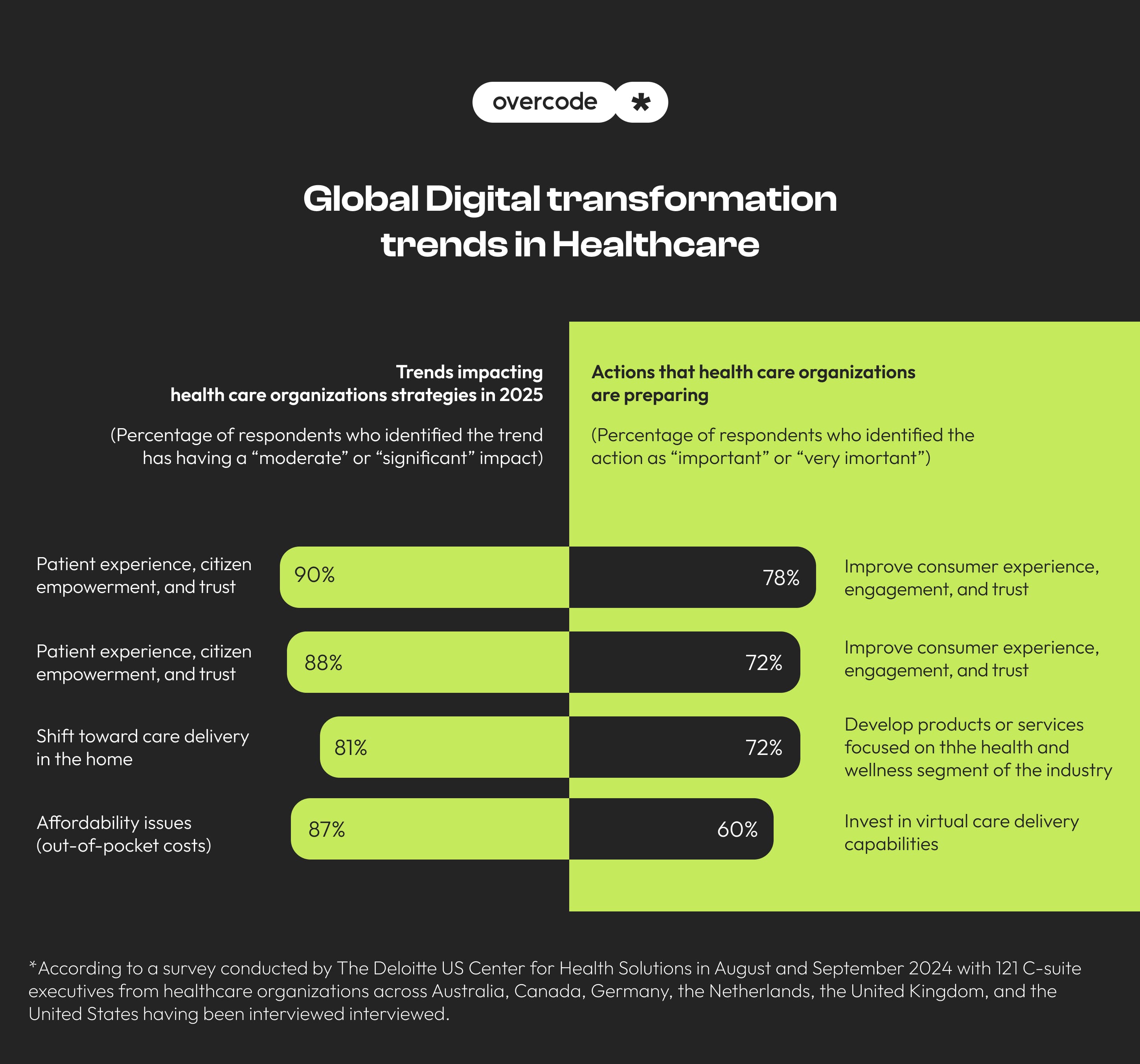
Healthcare software is a booming industry, and expectations are high for 2025. The global healthcare SaaS market was valued at about $34.84 billion in 2024 and is bound to reach $38.50 billion in 2025. It’s expected to grow by 10.5% annually, peaking at $94.56 billion by 2034.
In the United States, healthcare IT software was worth $166.83 billion in 2024, with a 15.46% compound annual growth rate projected through 2030.
Hardly any trend in 2025 is complete without an AI component in it. AI-powered healthcare software product development, from advanced diagnostics tools and predictive analytics solutions to automated administrative workflows, improves patient outcomes and drives financial gains. According to McKinsey, AI, traditional machine learning, and deep learning could generate up to $360 billion in net savings for healthcare systems.
The integration of AI into medical imaging is expected to continue evolving with advances in multimodal AI systems. In this way, it could be used even more frequently to analyze CT scans, MRIs, X-rays, and more, supporting clinical decision-making.
With all that said, the increasing use of AI in healthcare will only be fully accepted and processed if there are sufficient government regulations in place to ensure patient safety and data protection. Deloitte's survey of healthcare executives supports this statement:

What is the most popular type of software for healthcare?
EHRs take up a huge chunk of the healthcare software market. In 2023, the global EHR market was valued at approximately USD 32.23 billion, and is expected to grow at a compound annual growth rate of 4.43% from 2024 to 2030.
In the United States, the EHR market was worth USD 11.38 billion in 2023, a value that’s expected to grow at a CAGR of 2.24% until 2030.
What are the most popular healthcare software systems?
Here are some of the hottest medical software solutions right now:
Athenahealth is a cloud-based EHR with billing, coding, scheduling, and documentation tools.
Doxy.me is a leading telemedicine platform making virtual consultations smooth and simple.
Splose is a rising star in practice management for physiotherapists and chiropractors, using AI to automate booking and note-taking. It now serves over 15,000 users worldwide.
With AI, automation, and cloud-based platforms leading the charge, healthcare software in 2025 is all about making things faster, smarter, and more efficient.
When do you need custom medical software?
Off-the-shelf software does not always meet the needs of clinics and hospitals. If your system feels clunky, slows you down, or won’t play nice with other tools, it might be time to consider custom healthcare software types. Here’s when it makes sense:
Your workflow feels like a workaround
You know your software is not working if your teams would rather not use it. Custom software adjusts to your workflow, not the other way around.
Your systems don't talk to each other
If your staff is switching between EHR, billing, scheduling, and telemedicine systems, stuck copy-pasting data from one platform to another, you need a custom integration to make your processes much more efficient
You're worried you might not meet regulatory requirements
Regulations like HIPAA, GDPR, or PIPEDA aren’t optional. If your software isn’t airtight on security or doesn’t meet legal standards, you may have to turn to custom-built software for a more reliable solution.
You want AI and automation to do the heavy lifting
If you’re drowning in admin work, AI-powered smart scheduling, predictive analytics, and automated documentation can free up time. Off-the-shelf software might not have the AI features to meet your unique needs, but custom software can.
You're growing, but your software isn’t
If your current system struggles with more patients, locations, or data, you will have to turn to a custom-built platform that grows with you, keeping things running smoothly.
If your IT ecosystem is slowing you down instead of speeding you up, the advice for you is to consider custom software development for healthcare apps. It’s not about bells and whistles, it’s about making your job easier, keeping data secure, and preparing for growth.
Healthcare software products are critical to ensuring hospital operations are running smoothly. You can count on the right tools to slash admin work, cut down on errors, and help medical practitioners deliver better care. And Overcode can help you build them.
Software development for healthcare is one of our favorite areas of expertise. Various HealthTech & MedTech companies have tapped into our product development and staff augmentation expertise.
Book your free consultation today!
Doesn’t matter if you’re starting fresh or already have an existing product that needs some fine-tuning, our free 40-minute custom medical software development consultation can help you get on track. We’ll cut through the noise, help you prioritize, and give you a clear plan, plus real-world cost estimates and team recommendations.
